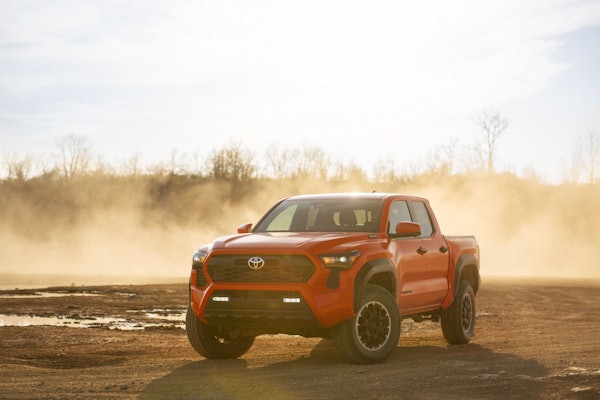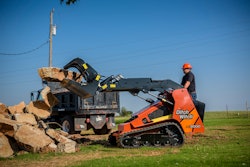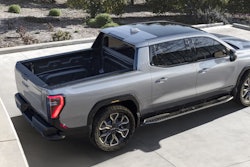Volvo has a new truck, and has built a high-horsepower, large-displacement diesel engine to power it. The company is known for advanced aerodynamics and technically advanced truck designs. The new VT 880 gives the company something it hasn’t had until now: a long-nosed conventional tractor that allows owners and drivers to project a strong, decidedly American image to their customers.
Because of its emphasis on aerodynamic design, Volvo had long resisted entering the long-nose conventional market, since such designs incorporate many features that can be highly inefficient on the highway. “Through customer clinics and focus groups, we identified the features and characteristics owners and drivers expect from their trucks,” says Ruben Perfetti, design director for Volvo. “Once we understood those desires, we created a Volvo solution for each one.”
Many respondents cited a long hood as particularly important. So Volvo delivered. The company retained excellent visibility from the cab by lowering the hood and using a massive, curved, one-piece windshield. In another example, Volvo positioned matched chromed air intakes on each side of the hood instead of using large, exterior-mounted air filters that create blind spots, increase aerodynamic drag and reduce fuel economy.
Volvo designers crafted the VT 880’s bumper to follow the curves of the truck around the front corners to the front wheels. “This makes it more aerodynamic,” Perfetti explains, “while still retaining the strong visual impact a large bumper makes. And because ours is a three-piece design, it’s easier and less expensive to repair.”
In addition to being designed for style and power, Perfetti says the VT 880 was engineered to deliver lower operating costs through better fuel economy, driver comfort and productivity and lower maintenance. At the same time, the truck is prepared to meet the tough cooling requirements that will come with the 2007 and 2010 emissions standards. Its large grille and long hood, combined with its aerodynamic features, work to channel airflow around the engine, keeping it cool even under demanding road conditions.
The VT880’s entire chassis has been tuned to provide a comfortable ride with smooth handling characteristics. Compared to the Volvo VN 780, the VT 880’s front axle has been positioned forward 12.4 inches to optimize airflow while delivering 45-degree wheel cuts. At the same time, the cab has been positioned back 8 inches to further isolate the driver from road noise and vibration. The cab is constructed from welded, high-strength steel. Bendix’s enhanced stability braking systems are available to ensure smooth, even braking in all road conditions.
16-liter power for tough hauling applications
The new 16-liter D16 diesel engine is the heart of the VT 880. Volvo claims it’s the most powerful diesel truck engine available in North America today. The engine was designed from its inception to provide the VT 880 with maximum performance and fuel economy in terms of high-speed gradability, drivability and usable power. As an example of its capabilities, Volvo engineers say a D16-powered VT 880 operating with an 80,000-pound load can maintain 65 mph on a 3-percent grade while running at 1,400 rpm.
“Volvo has a 20-year legacy of building 16-liter engines for the Australian market,” notes Ed Saxman, product manager, powertrains. “So this isn’t new technology for us.” Saxman says Volvo engineers used existing Volvo technology and design templates to create an all-new engine with a Volvo heritage, resulting in an engine that “looks like a D12 on steroids.”
The D16 is available in four power ratings:
- 500 horsepower at 1,850 pounds-feet of torque
- 550 horsepower at 1,850 pounds-feet of torque
- 600 horsepower at 2,050 pounds-feet of torque
- 625 horsepower at 2,250 pounds-feet of torque
The engine also introduces a new Volvo technology called Intelligent Torque, or I-Torque, which is designed to protect drivelines from excessive engine torque at low speeds. I-Torque works by limiting engine torque output to 1,650 pounds-feet in startup gears, then switching to 1,850 pounds-feet as the truck’s speed increases.
Volvo says the D16’s larger displacement gives it advantages over 15-liter engines currently on the market. “The larger bore of the D16’s cylinders gives the tops of its pistons more surface area,” explains Saxman. “This means the D16 can generate more power and torque than a 15-liter engine with lower internal forces. And its shorter stroke means less piston travel inside the cylinder – all of which leads to less engine wear and longer service life.”
Saxman says service life is also enhanced by the length of the D16’s engine block. This design features more space between the cylinders, which Volvo says creates a stronger base engine block and delivers more consistent engine temperatures, reducing mechanical and thermal stresses.
The D16 has a rear-mounted gear train that drives the camshaft, air compressor and power steering pump. A damper on the camshaft reduces torsional vibrations for a smoother, quieter drive. The cam is designed to lift up and out of the engine for easy servicing. Technicians do not have to remove the engine or the radiator to get to it.
Other D16 innovations include the new Volvo engine brake – a completely integrated engine compression brake that provides 335 horsepower of braking energy at 1,500 rpm. Volvo’s exhaust pressure governor system allows the engine to warm up quickly and maintain constant engine temperatures at low idle speeds. Volvo engineers say this saves fuel and reduces emissions. The pressure governor also works with the engine brake to provide high retarding power throughout the engine’s rpm range. A new engine pre-heater heats intake air for fast and reliable engine startups in cold weather, reducing stress on engine components and reducing white smoke emissions.









